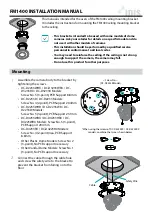
Airbridge BTS3606E&3606AE
System Commissioning Guide
3 Commissioning Process
Issue 02 (2006-10-10)
Huawei Technologies Proprietary
3-27
Parameter
Description
Revs pwr
Reverse power
RF AGC gain
AGC gain of radio frequency
Example of Test Result
The following shows the RSSI value of the CMTR or OMTR configured in slot 2:
HW CBTS>str infotrace : brdtp=trm,brdid=2,item="rssi"
Ok
Carrier0 RSSI: Main Avg = -115.5, Main Peak = -114.3, Main Ratio = 0%
Carrier0 RSSI: Divs Avg = -109.8, Divs Peak = -108.7, Divs Ratio = 0%
Carrier1 RSSI: Main Avg = -115.9, Main Peak = -114.4, Main Ratio = 0%
Carrier1 RSSI: Divs Avg = -109.8, Divs Peak = -108.8, Divs Ratio = 0%
Carrier2 RSSI: Main Avg = -116.4, Main Peak = -114.4, Main Ratio = 0%
Carrier2 RSSI: Divs Avg = -109.8, Divs Peak = -108.8 Divs Ratio = 0%
Revs pwr: Main = -83.3, Divs = -97.1; RF AGC gain: Main = 0.0, Divs = 0.0
Analysis of Test Result
z
If the main RSSI average value (Main Avg) ranges from –100.0 dBm to –108.0 dBm, the
main receive channel is normal.
z
If the diversity RSSI average value (Divs Avg) ranges from –100.0 dBm to –108.0 dBm,
the diversity receive channel is normal.
z
In the case of empty load, the average value of RSSI ranges from –105.0 dBm to –112.0
dBm.
z
The average value difference between the main RSSI and diversity RSSI must be from 2
dB to 3 dB.
Troubleshooting
If the measured RSSI value is too small, check the connections of:
z
Antenna and feeder
z
Ports on top of the cabinet
z
CDDU or IDFU/ODFU
z
RF subrack
If the RSSI value is too large, check if there is an interference source nearby.
3.6 Service Function Test
The service function test help verify BTS services and functions.
They comprise:
z
Location update test
z
BTS coverage test









































